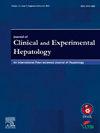肝梗塞:非移植医学尸检中发现的不常见血管并发症的不常见原因
IF 3.3
Q2 GASTROENTEROLOGY & HEPATOLOGY
Journal of Clinical and Experimental Hepatology
Pub Date : 2025-02-22
DOI:10.1016/j.jceh.2025.102533
引用次数: 0
摘要
背景和目的肝梗死是一种罕见的血管病变,由于肝脏的双血管供应,其特征是位于肝实质周围的楔形大坏死区。它们通常被视为肝移植的并发症。材料和方法检索医学尸检中发现的肝梗死病例,检索其临床、生化、大体和组织形态学细节。结果在连续1865例成人和儿童尸检中发现3例肝梗死(0.2%)。这些病例分别发生在24岁男性、19岁男性和28岁产后女性,由大黄蜂蜇伤、急性胰腺炎、溶血、肝酶升高、低血小板综合征(HELLP)引起。前2例患者转氨酶升高50 ~ 150倍,合并高胆红素血症。所有病例均表现为充血至苍白的包膜下梗死。HELLP综合征病例显示静脉窦内富含纤维蛋白的微血栓,而另外两例显示富含纤维蛋白/有组织的微血栓,涉及不等大小的门脉和中心静脉根。其中两例(大黄蜂蜇伤和HELLP综合征)在门静脉、肝动脉或肝静脉未见任何宏观血栓。结论肝梗死是一种罕见的非移植肝血管病变。这些病变的大体和组织形态学取决于这些病变的年龄。它们可以在没有任何宏观血栓记录的情况下发生血管微血栓。本文章由计算机程序翻译,如有差异,请以英文原文为准。
Hepatic Infarct: Uncommon Causes of an Uncommon Vascular Complication Revealed at Nontransplant Medical Autopsies
Background and aims
Hepatic infarcts are uncommon vascular lesions due to dual vascular supply of the liver characterized by the peripherally-located wedge-shaped large zones of necrosis in the hepatic parenchyma. They are commonly seen as a complication of liver transplant.
Material and methods
The cases of hepatic infarcts of the native liver detected in medical autopsies were searched in the archives and their clinical, biochemical, gross, and histomorphological details were retrieved.
Results
Three cases of hepatic infarct of the native liver were detected from among 1865 consecutive cases of adult and pediatric autopsies (0.2%). These cases were caused by hornet stings, acute pancreatitis, and hemolysis, elevated liver enzymes, low platelet syndrome (HELLP) in a 24-year-old male, 19-year-old male, and a 28-year-old postpartum female, respectively. The first two cases showed 50–150 times elevated transaminases and conjugated hyperbilirubinemia. All cases showed hyperemic to pale subcapsular infarcts. The HELLP syndrome case showed intrasinusoidal fibrin-rich microthrombi, while the other two cases showed the presence of fibrin-rich/organized microthrombi involving variable-sized portal and central venous radicles. Two of these cases (hornet sting and HELLP syndrome) did not show any macroscopic thrombi in the portal vein, hepatic artery, or hepatic veins.
Conclusion
Hepatic infarcts are rare vascular lesions found in the nontransplant liver. The gross and histomorphology of these lesions depend on the age of these lesions. They can occur in the presence of vascular microthrombi in the absence of any documented macroscopic thrombus.
求助全文
通过发布文献求助,成功后即可免费获取论文全文。
去求助
来源期刊

Journal of Clinical and Experimental Hepatology
GASTROENTEROLOGY & HEPATOLOGY-
CiteScore
4.90
自引率
16.70%
发文量
537
审稿时长
64 days
 求助内容:
求助内容: 应助结果提醒方式:
应助结果提醒方式:


